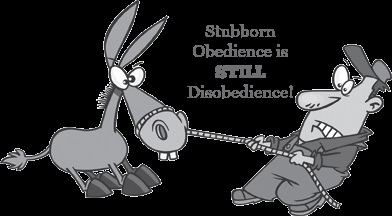
There is always some kind of order by a superior or authority to a subject for a certain thing to be accomplished within a given frame of time. Abreast of this, it is expected of the subject to be willing to diligently discharge his duties or what he is ordered to do; that is what we refer to as obedience. To a lay man, obedience has a positive implication in guiding a person’s attitude for whatever he does, and disobediences, the opposite. Although man is endowed with a gift of intellect in which his mind has the power to reason. Yet, he is noted inclining to feelings that override his capacity to do right. Hence, obedience and disobedience seem to be intermingled in the person’s interaction with the authority. The question of obedience and disobedience is a matter of great consideration. Animals are guided by behavior and whatever the behavior dictated is perfectly discharged; they cannot do the otherwise whatsoever. Machines absolutely obey whatever task they are given.
Many people would describe the relationship between these two words (obedience and disobedience) as opposites. However, the relationship between these two words is not as opposites, but as interlinked and related. In order to understand obedience and disobedience they need to be broken down further into constructive and destructive obedience and anti-social and pro-social disobedience. The difference between all four of these terms helps to understand the relationship and apply it to different situations in society. Destructive obedience, or better known as blind obedience, is dangerous. It allows an authority to order his subjects to do things even if they are harmful. The authority, forcing them to do things against their moral standing out of fear exhibits the extent of human atrocities. Constructive obedience is more of a responsibility for themselves to know when to follow the authority or when not to. Disobedience is defined in two ways: It is either a way to undermine authority’s legitimacy or it may be a check upon the authority’s control. Anti-social disobedience is defined as selfish and is also used to further a group’s agenda and goals. Whereas pro-social disobedience is defined by groups or people who promote social change and help to prevent the degeneration of authority by controlling the legitimacy of its demands. Some groups may think that they further pro-social disobedience, when in fact they are anti-social disobedience due to their own selfish motives. As a matter of fact, in most cases, obedience and disobedience are tied together or intermingled; where one ends, the other springs up. People who understand obedience also understand disobedience. Instead of disobeying every command, they understand the structure of obedience and the need to keep it in balance with each other in order to prevent anarchy and chaos. Even though of the objective reality appears rather shaky, to maintain social, political and economic stability it preferable to obey the legitimate authority.
Coupled withthis, the impact of obedience and disobedience studies on personality and Social Psychology should be examined thoroughly.
The writer can explain what really happens between the relationship of authority, obedience and disobedience. In addition, this article is sparking the writer’s interest in the authority and obedience relationship in cultures that are authority-based like it was in feudal Ethiopia. It brings up an important question: Are people who come from a more authority-based culture, more likely to obey an authority? This will certainly help explain past examples of situations, where some people obeyed and others did not. Using this article, it can be used to explain not only human atrocities, but also social changes throughout history. In addition, it has changed the writer’s views of obedience and disobedience. Even though it is still based on the writer’s own opinions about authority and obedience, it has broadened the view of obedience may be a good thing in certain situations and is still needed in society and government. Throughout this article, authority, obedience, and disobedience and their relationship are thoroughly explained. They are all tied with each other somehow; understanding this will be very benefitting.
As we all know obedience has an important place in the long history of mankind. At first, obedience was a wanted quality in a parent-child relationship. Obedience in a child was and is still most desirable personal quality in children. This is essentially true because in Ethiopia many people live by the bible and its commandments and teachings are followed strictly. However, lately, this is tragically changing with children whose parents are indifferent about moral standard of their children. Nevertheless, psychologists caution about the danger in blind obedience. Even though obedience is highly wanted in a child, it must lovingly and gently be encouraged or motivated for the children to willingly want to obey. On the other hand, the child also has the option not to obey or rather disobey authority if he has a convincing justification to act likewise. The personality development fields such as personality, behavioral psychology, and social psychology must effectively be in place. For instance Miglram, a researcher in this particular field, in her experiment, has added information onto the science side, but has taken away something on the moral side; the unethical side. Milgram’s experiment has placed restrictions on ethical standards. That is why strong protection of human subjects in research is needed. Her experiment has placed a large emphasis on social psychology research and the curiosity of how people work in salutations.
In response, there have been some very unethical experiments conducted in the name of science and it did provide great insight to the topic at hand, yet, the problem is that it was unethical. Take prison experiment in any form, is highly unethical. Even though the experiment is unethical, it provides insight into the stereotyping part of society. Making a person harm another person, even though the other person is not harmed, the psychological wounds inflicted on those children, flipping the switches, are scarring. Although it does provide insight into obedience in society and also it explains many situations about authority and obedience in the social context. This helps us explain the relationship and influence between authority and obedience. After all, Obedience pays off in the long run. If children obey their parents, life would be much better for the family. The parents would be pleased with their children and the children would probably stay out of trouble.
At the same time, children who disobey their parents probably will disobey their teachers and others in their lives; the situation which can have dire consequences. Rules and regulations are designed to keep us out of trouble. If we ignore the rules and regulations of society, there is good chance we will end up in prison; and there are a lot of people going to prison these days. As we learn from our daily news, the United States has the highest incarceration rates in the world. So we must emphasize the need for obedience at an early stage in life. We should respect the laws and rules of the country and then we will have the protection that law enforcement offers. No one wants to end up in prison. The state of someone who has to spend years of his life locked up is hopeless. No soul should replicate such a state even though disobedience sometimes has its own good consequence. Whatsoever, let’s all lean to righteousness!
BY JOSEPH SOBOKA
The Ethiopian Herald May 14/2021





